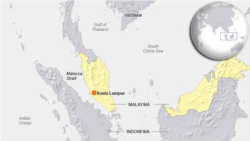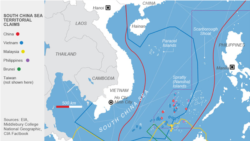Indian Navy warships have held a joint exercise with the United States Navy in the Indian Ocean, according to the two countries.
The maritime drill signals growing strategic cooperation between New Delhi and Washington at a time of heightened tensions with China.
The exercises began Monday near India’s Andaman and Nicobar Islands, which are located away from the Indian mainland, near one of the world’s busiest shipping routes close to the Malacca Strait.
The Indian navy called the drills a “passage exercise,” a reference to maneuvers held by two countries when a transiting warship joins another.
U.S. Secretary of Defense Mark Esper said Tuesday the combined exercise between the Indian Navy and the USS Nimitz aircraft carrier demonstrated the two countries’ “shared commitment to stronger naval cooperation and support of a free and open Indo-Pacific.”
India and the U.S. carried out their first ever joint military exercise last November, and they plan to hold a two-plus-two ministerial dialogue later this year to build on their cooperative progress, according to Esper.
Rear Admiral Jim Kirk, commander of the Nimitz Carrier Strike Group, said in a statement that the “series of exercises improved our interoperability and is a testimony to the flexibility of both our Navies."
Earlier this month two U.S. aircraft carriers, the USS Nimitz and the USS Ronald Reagan, conducted joint operations to demonstrate freedom of navigation in the South China Sea, where territorial disputes have flared between China and its smaller neighbors. The United States has rejected China’s territorial claims as “unlawful.”
The deployment was the first time the U.S. has conducted dual carrier operations since 2012.
Last year, the U.S. military conducted more freedom of navigation operations in the South China Sea than in any year since it began these types of operations in 2015, as a means of more aggressively challenging Chinese territorial claims there.
China considers much of the sea its territory — overlapping with the territorial claims of other nations — and has created hundreds of hectares of artificial islands to bolster is territorial claims. The U.S. frequently conducts freedom of navigation operations in the South China Sea to dispute China's claims and to promote free passage through international waters that carry about half the world's merchant fleet tonnage, worth trillions of dollars each year.
Although New Delhi has steered clear of making any statement on the competing claims in the contested waters, the Indian Foreign Ministry said last week the South China Sea was “part of global commons, and India has an abiding interest in peace and stability in the region."
Tensions between India and China are at their worst in decades following a clash over their disputed border in the Himalayas that killed 20 Indian soldiers.
Defense Secretary Esper on Tuesday said the U.S. was closely monitoring the situation between India and China, adding that he was “pleased to see that both sides are trying to deescalate the situation."
Analysts say deteriorating ties between the Asian neighbors will push New Delhi to build closer strategic ties and deepen naval cooperation with Washington.
India is widely expected to clear the way for including Australia in the annual Malabar exercise that it holds with the United States and Japan, in a sign that the four navies intend closer collaboration with an eye on China.










